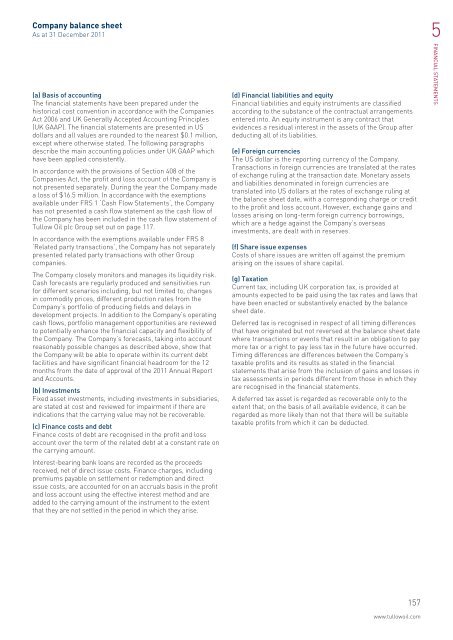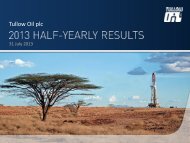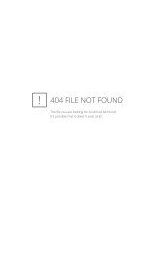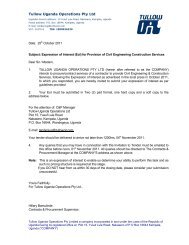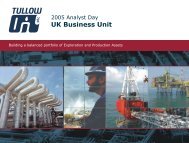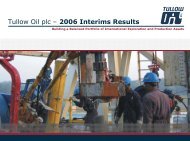2011 Annual Report PDF - Tullow Oil plc
2011 Annual Report PDF - Tullow Oil plc
2011 Annual Report PDF - Tullow Oil plc
Create successful ePaper yourself
Turn your PDF publications into a flip-book with our unique Google optimized e-Paper software.
Company balance sheet<br />
As at 31 December <strong>2011</strong><br />
(a) Basis of accounting<br />
The financial statements have been prepared under the<br />
historical cost convention in accordance with the Companies<br />
Act 2006 and UK Generally Accepted Accounting Principles<br />
(UK GAAP). The financial statements are presented in US<br />
dollars and all values are rounded to the nearest $0.1 million,<br />
except where otherwise stated. The following paragraphs<br />
describe the main accounting policies under UK GAAP which<br />
have been applied consistently.<br />
In accordance with the provisions of Section 408 of the<br />
Companies Act, the profit and loss account of the Company is<br />
not presented separately. During the year the Company made<br />
a loss of $16.5 million. In accordance with the exemptions<br />
available under FRS 1 ‘Cash Flow Statements’, the Company<br />
has not presented a cash flow statement as the cash flow of<br />
the Company has been included in the cash flow statement of<br />
<strong>Tullow</strong> <strong>Oil</strong> <strong>plc</strong> Group set out on page 117.<br />
In accordance with the exemptions available under FRS 8<br />
‘Related party transactions’, the Company has not separately<br />
presented related party transactions with other Group<br />
companies.<br />
The Company closely monitors and manages its liquidity risk.<br />
Cash forecasts are regularly produced and sensitivities run<br />
for different scenarios including, but not limited to, changes<br />
in commodity prices, different production rates from the<br />
Company’s portfolio of producing fields and delays in<br />
development projects. In addition to the Company’s operating<br />
cash flows, portfolio management opportunities are reviewed<br />
to potentially enhance the financial capacity and flexibility of<br />
the Company. The Company’s forecasts, taking into account<br />
reasonably possible changes as described above, show that<br />
the Company will be able to operate within its current debt<br />
facilities and have significant financial headroom for the 12<br />
months from the date of approval of the <strong>2011</strong> <strong>Annual</strong> <strong>Report</strong><br />
and Accounts.<br />
(b) Investments<br />
Fixed asset investments, including investments in subsidiaries,<br />
are stated at cost and reviewed for impairment if there are<br />
indications that the carrying value may not be recoverable.<br />
(c) Finance costs and debt<br />
Finance costs of debt are recognised in the profit and loss<br />
account over the term of the related debt at a constant rate on<br />
the carrying amount.<br />
Interest-bearing bank loans are recorded as the proceeds<br />
received, net of direct issue costs. Finance charges, including<br />
premiums payable on settlement or redemption and direct<br />
issue costs, are accounted for on an accruals basis in the profit<br />
and loss account using the effective interest method and are<br />
added to the carrying amount of the instrument to the extent<br />
that they are not settled in the period in which they arise.<br />
(d) Financial liabilities and equity<br />
Financial liabilities and equity instruments are classified<br />
according to the substance of the contractual arrangements<br />
entered into. An equity instrument is any contract that<br />
evidences a residual interest in the assets of the Group after<br />
deducting all of its liabilities.<br />
(e) Foreign currencies<br />
The US dollar is the reporting currency of the Company.<br />
Transactions in foreign currencies are translated at the rates<br />
of exchange ruling at the transaction date. Monetary assets<br />
and liabilities denominated in foreign currencies are<br />
translated into US dollars at the rates of exchange ruling at<br />
the balance sheet date, with a corresponding charge or credit<br />
to the profit and loss account. However, exchange gains and<br />
losses arising on long-term foreign currency borrowings,<br />
which are a hedge against the Company’s overseas<br />
investments, are dealt with in reserves.<br />
(f) Share issue expenses<br />
Costs of share issues are written off against the premium<br />
arising on the issues of share capital.<br />
(g) Taxation<br />
Current tax, including UK corporation tax, is provided at<br />
amounts expected to be paid using the tax rates and laws that<br />
have been enacted or substantively enacted by the balance<br />
sheet date.<br />
Deferred tax is recognised in respect of all timing differences<br />
that have originated but not reversed at the balance sheet date<br />
where transactions or events that result in an obligation to pay<br />
more tax or a right to pay less tax in the future have occurred.<br />
Timing differences are differences between the Company’s<br />
taxable profits and its results as stated in the financial<br />
statements that arise from the inclusion of gains and losses in<br />
tax assessments in periods different from those in which they<br />
are recognised in the financial statements.<br />
A deferred tax asset is regarded as recoverable only to the<br />
extent that, on the basis of all available evidence, it can be<br />
regarded as more likely than not that there will be suitable<br />
taxable profits from which it can be deducted.<br />
5<br />
FINANCIAL STATEMENTS<br />
157<br />
www.tullowoil.com


